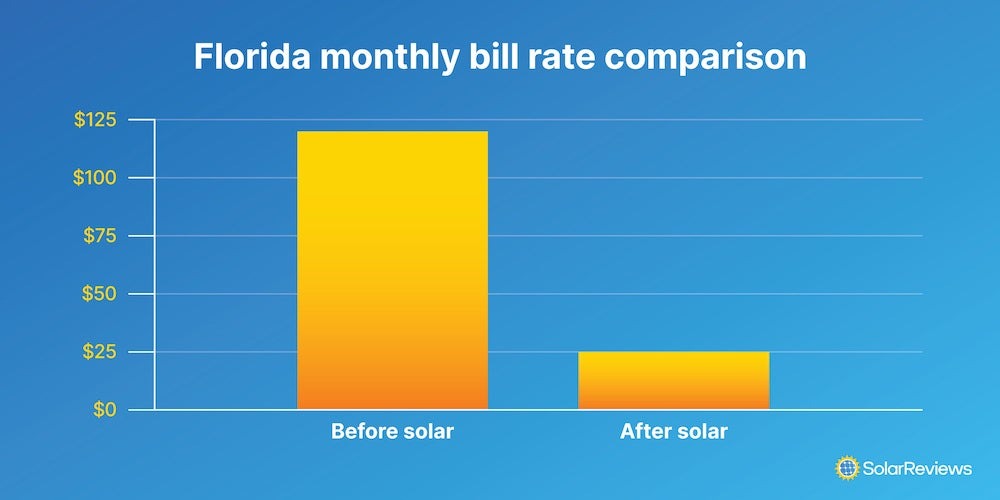Updated 11 months ago
What is the average electric bill in Florida in 2025?
Written by
Jamie Smith

Find out how much solar panels can save on your Florida electric bill
From theme parks to hurricane season – Florida’s got a lot going on. It’s not just a popular travel destination, it’s a forever home for most.
If you’re looking to retire, start a family, or simply want a change of scenery, you might have wondered how much it’ll cost to live there. Florida was one of the cheapest places to live in the U.S., but lately, electricity rates have been climbing. According to data from the U.S. Energy Information Administration (EIA), the current electricity rate in Florida has climbed up to $0.14 per kilowatt hour (kWh) consumed.
In this article, we’ll be breaking down how much the average monthly electric bill in Florida costs – and how installing solar can help. They don't call Florida the Sunshine State for nothing!
Key takeaways
-
The average homeowner’s electricity bill in Florida is $157 per month.
-
Florida experiences more power outages than other areas of the U.S. due to the area’s high volume of hurricanes and tropical storms.
-
Along with harsh weather conditions, natural gas prices, and your electric provider’s rates can significantly impact your electric bill.
-
Solar panels can potentially eliminate your Florida electricity bill, saving you hundreds of dollars a month.
-
Many areas of Florida offer energy-assistance programs to help those struggling to pay their utilities during this spike in energy prices.
What is the average electric bill in Florida in 2025?
In 2025, the average electric bill in Florida is $157 per month, which is a bit higher than the current national average of $139. Despite this, Florida electric rates are slowly creeping down. According to EIA data, Florida rates are down about 8% from 2023.
Although electric rates are going down, monthly bills are still higher than the national average, mainly due to high electricity consumption. Florida heat is no joke – and those cooling systems are working overtime!
Why have Florida electricity rates increased so much?
There are a few reasons why utility rates have skyrocketed in the past few years. For one, the cost of fuel has gone up drastically. Florida uses natural gas to produce most of its electricity, and it has to purchase it from out of state. Natural gas has become substantially more expensive to get to Florida due to the COVID-19 pandemic and the war in Ukraine. In turn, electricity prices have increased.
Also, Florida regularly experiences harsh weather conditions like hurricanes and tropical storms, which cause significant damage to utility infrastructure. To fund the repairs, utility companies increase customer rates.
What factors affect your electricity bill in Florida?
The average electricity bill in Florida is just that - an average. Several things can impact how much you pay for electricity every month, including your energy consumption and electricity rates.
Consumption
When it comes to electricity bills, the more kWh you consume, the higher your electric bill will be. The amount of energy you use will vary depending on the types of appliances you have, the number of people in your home, and how energy efficient your house is.
Florida’s weather also makes a difference. Homes in Florida use more energy, in part because of the weather. The hot Florida weather means you’ll be cranking your air conditioner more than someone in chilly Massachusetts.
It’s almost impossible to quantify all of these things, but you can make a rough estimate based on the square footage of your home. The table below outlines how much you can expect to pay for electricity each month on average for different-sized homes:
Home type | Est. monthly electricity consumption | Avg. monthly electric bill |
|---|---|---|
One-bedroom apartment | 400 kWh | $56 |
Two-bedroom apartment | 550 kWh | $77 |
Small house* | 730 kWh | $102 |
State average | 1,107 kWh | $157 |
Large house** | 1,683 kWh | $235 |
*Based on a 1,300 sq. ft. home
**Based on a 3,000 sq. ft. home
Electric provider
Each utility company has different electricity rates for their customers. The four major investor-owned utility rates in Florida are:
Utility company | Avg. electricity rate* |
|---|---|
$0.17 per kWh | |
$0.14 per kWh | |
Florida Public Utilities Company | $0.15 per kWh |
$0.14 per kWh |
*Actual electricity rate will vary depending on usage and rate schedule
Duke Energy Florida uses seasonal rates, so the exact amount you pay may vary with the time of year. If you use a time of use rate schedule, you’ll pay different rates at different times of day. You can lower your electricity bill by using most of your energy when electricity is the cheapest.
FPL also announced changes to their rates over the past few months as natural gas prices are projected to drop slightly. If natural gas prices continue to fall, your electricity rate could follow.
Energy-assistance programs in Florida
Electric prices across the country have been soaring, and customers are not happy about it. A few states and major cities have enacted programs to help those struggling with rising utility bills.
Luckily, the Sunshine State is one of them. Qualifying residents can take advantage of the Low Income Home Energy Assistance Program (LIHEAP), which helps low-income households pay for their heating and cooling energy costs. The Program also provides bill payment assistance, energy crisis assistance, weatherization, and energy-related home repairs.
With Florida being a state that experiences major storms and crises, this program is extremely beneficial to those who might have a harder time paying for it when the time comes.
There are plenty of other regional programs in Florida to assist with your utility bills when you need it most!
How going solar can help you save money in Florida
With electricity rates skyrocketing in Florida, solar panels are a better investment than ever! High electricity prices means higher solar savings, and Florida’s full retail net metering program gives you the best bang for your buck.
Florida residents can also take advantage of the 30% federal tax credit, which can reduce the cost of installing solar panels by thousands of dollars. Lower upfront costs mean you can see an excellent return on your solar investment, and start getting free solar electricity sooner!
With all the sunshine Florida gets – your solar system will be able to save you thousands of dollars a year! You can see in the graph below just how much of a difference solar can make to your electric bill – the savings will be pouring in!

Residential customers can benefit greatly from installing solar in their homes. It’s a perfect way to practice being more energy-efficient to benefit the environment while saving you some money! And who doesn’t love to save money?
Can solar panels withstand extreme weather conditions?
Considering all of the hurricanes that happen in Florida – we can understand you being hesitant to invest in a solar system.
It’s important to know that any reputable solar panel brand is built to last – even in the harshest weather conditions. This might just require you to do a little bit of research on good solar panel brands. Most areas of Florida even require solar installations to withstand winds of 160 mph minimum, so you shouldn’t have much to stress about!
Get an expert opinion from a local installer to be extra sure. In the meantime, enter your details into our solar calculator to find out if switching to solar is the right choice for you!
Jamie is a Content Writer and researcher at SolarReviews. A recent graduate of La Salle University in Philadelphia, Jamie earned her B.S. in communications with a concentration in journalism, mass media, and public relations. Jamie has previously worked at a marketing company where she had the opportunity to highlight and promote small business owners through long-form stories and interviews. With a deep-rooted passion for creativity, Jamie stri...
Learn more about Jamie Smith